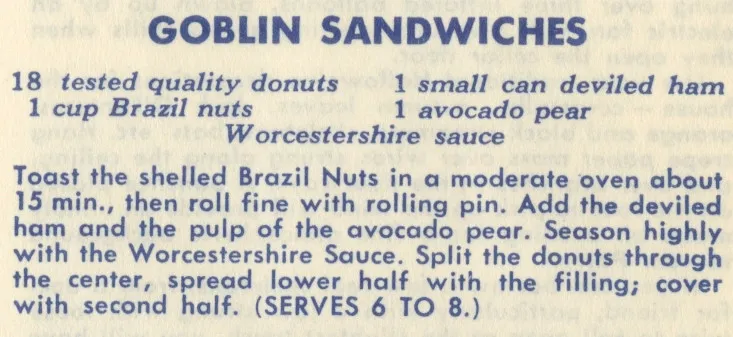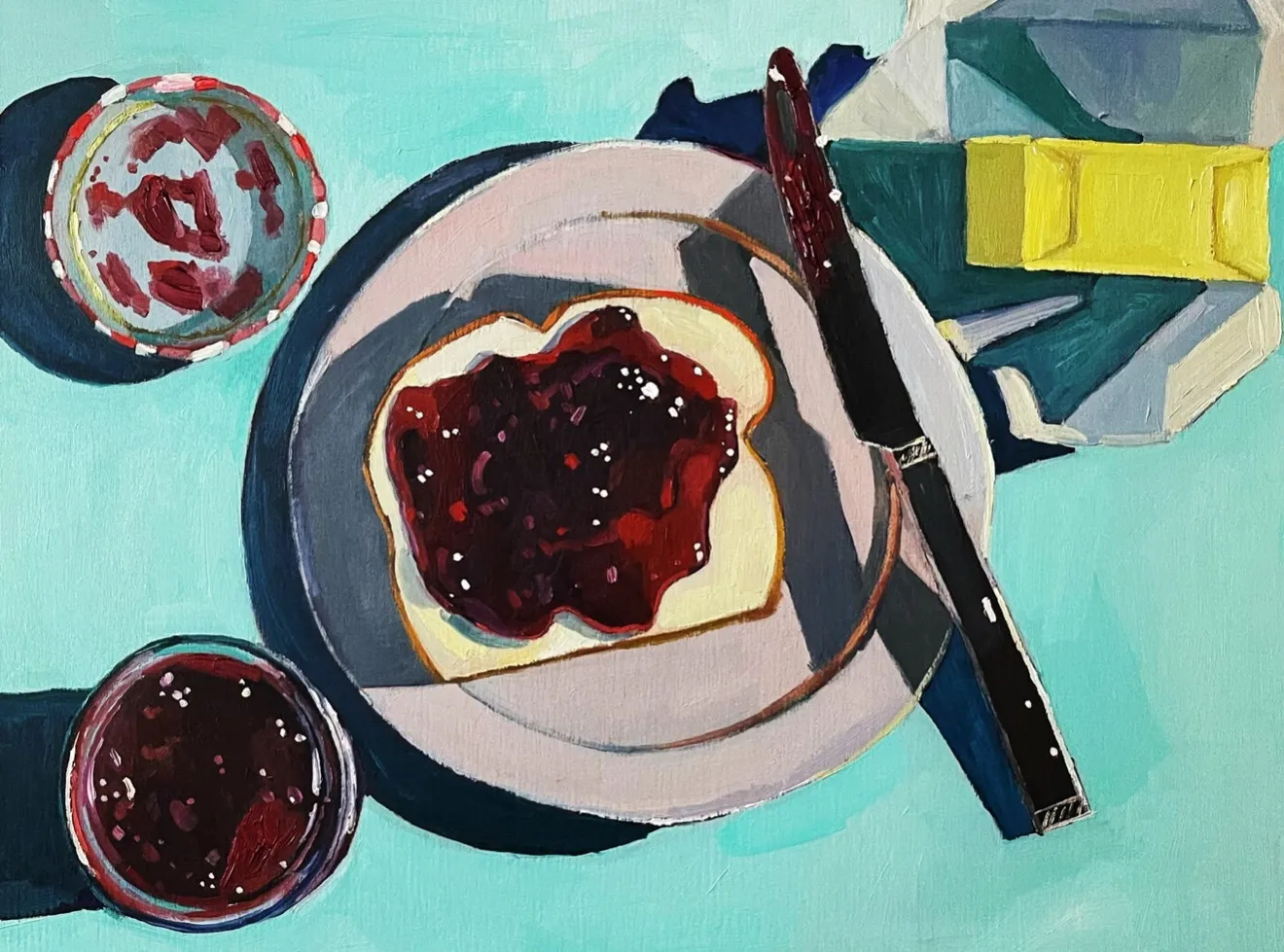For the Squares: Chicago Tavern-Style Pizza
A guest post & recipe from John Carruthers
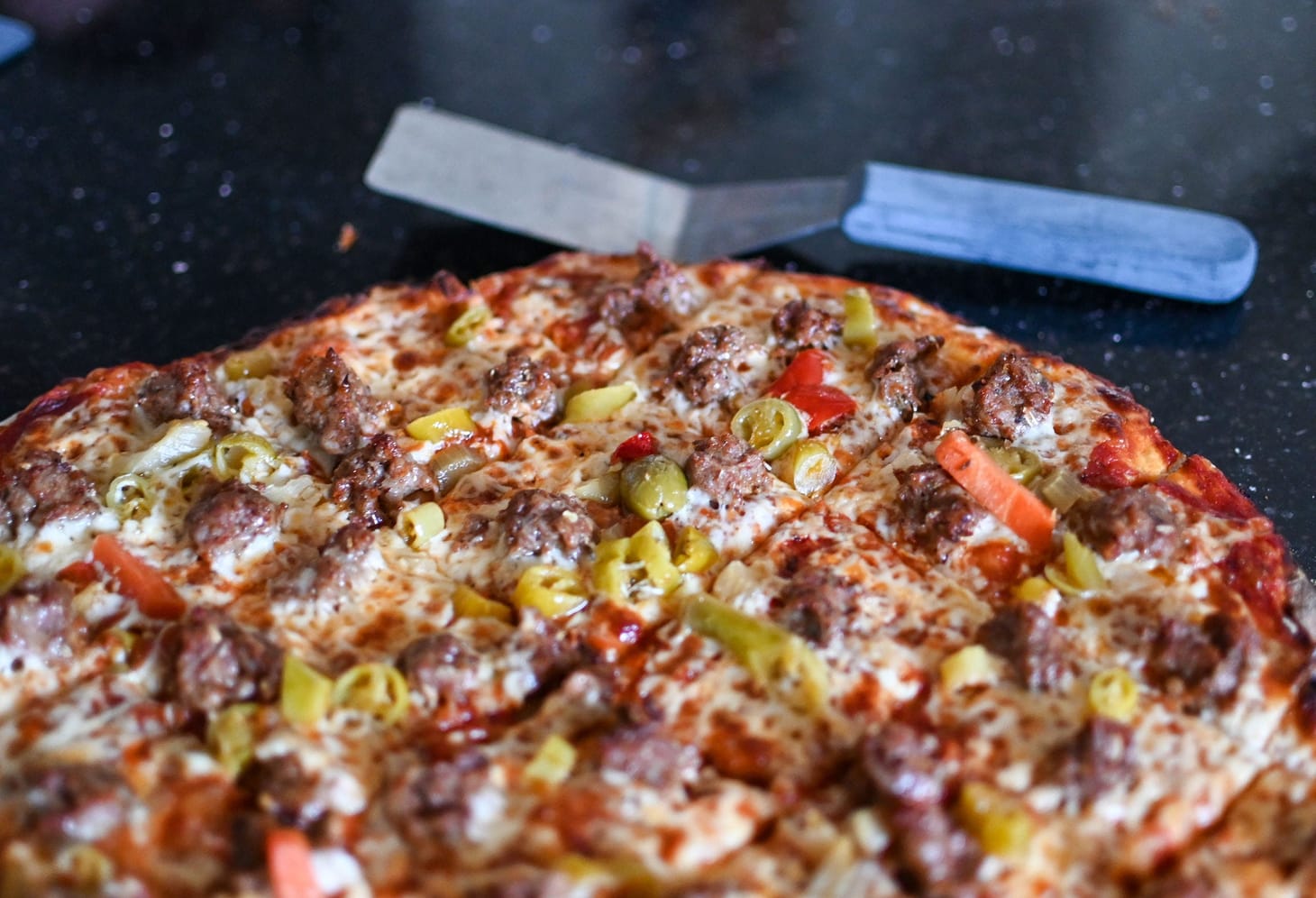
Table of Contents
I am super excited to share this week’s guest post, from John Carruthers, aka Crust Fund Pizza, a Chicago home pizza maker whose amazing tavern-style pies have raised more than $42k for local charities. I first discovered John and his awesome-looking, do-good pies when I heard about Pizza for Everyone, the pizza recipe compilation book he produced, also for charity. (A second volume of PfE is in the works and will include a recipe from yours truly.)

John first wrote about tavern-style pizza for The Takeout back in August, 2020, in a piece entitled The Pizzadad Chronicles, or my obsessive quest to make the best Chicago tavern-style pie at home. Here’s how he describes this style of pie, which most Chicagoans consider their actual native pizza (rather than the bread-casseroles-of-excess most outsiders associate with the city):
What is tavern-style pizza?Tavern style is the square-cut thin crust pie that most Chicagoans grow up eating. It’s crisp in bite, sweet and herbaceous in sauce, and balanced in toppings. I won’t belabor the point that locals don’t usually partake in the deep dish you all associate us with (and, frankly, Gwen Ihnat said it all), but it’s at least worth mentioning here.
Chicago tavern-cut pizza originated in taverns, if you can believe it. Bar owners would set out pizza for drinkers cut into bite-sized squares in order to stretch the free food and eliminate the need for plates. Bar patrons could have a couple of squares on a napkin and still have room for their dinner. (This was, I should note, a period when a far greater proportion of men than today went to work, got loaded at bars, and then went home to the family.)
Some also call it “party cut” for its popularity at birthday parties. I knew my own recipe was dead-on when I could close my eyes, take a bite, and instantly be transported to Denise McCarthy’s ninth birthday party at the 3-D Bowl in Island Lake, Illinois.
Bottom line: this is a regional pizza style that some people fall hard for, and I’m currently using it as a substitute for meaningful relationships with people outside of my blood family. And I have to say, that’s all going pretty great.
I’ve never eaten Chicago tavern pizza, but I’ve seen enough of John’s pies online to know I’d love it, which was why I asked him to share a recipe with you all here. He was happy to, and, true to form, he asked that I donate his contributor fees1 to a charity, in this case Mobile Makers, a Chicago-based org that “creates programming that encourages youth to become advocates and change-makers in their own communities through design-focused skill-building workshops.”
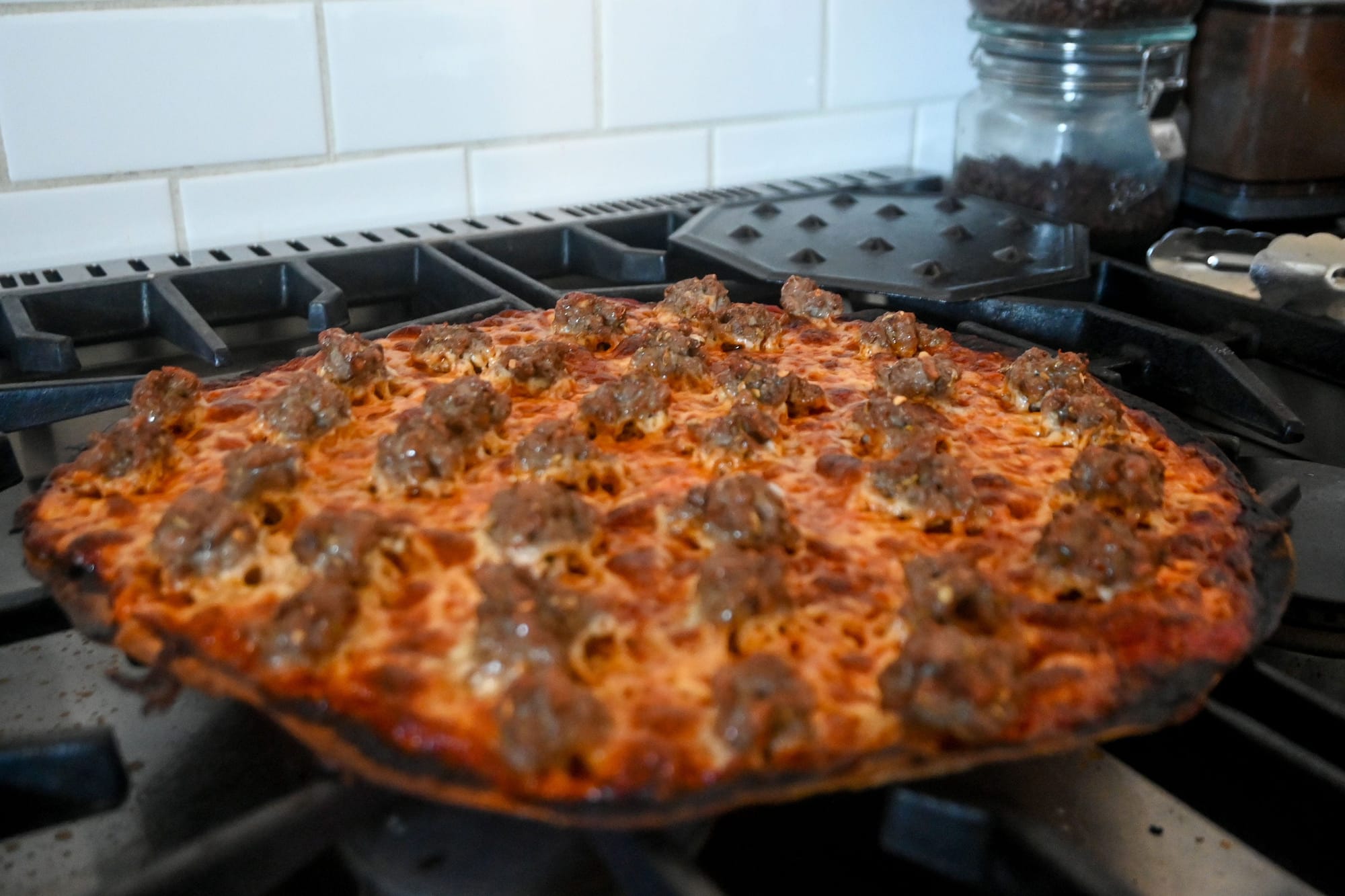
I’ve made one major change to John’s recipe, which was to divide it in half to yield two pizzas instead of four, which I think will make the process a little easier for first-timers. And I’ve footnoted it with the answers that John gave me to the questions that came up when I first read it. The format here is a little different than our usual one, but I think it works well as a recipe walk through. For the PDF, I have organized it more traditionally:

John Carruthers’ Chicago Tavern Style Pizza1.04MB ∙ PDF fileDownloadDownload

The most important (and most interesting element) of this recipe is the dough “curing” step, in which you place the rolled-out discs onto parchment and let them sit, uncovered, in the fridge for a day, during which time the top surface of the dough dries out. When the disc is inverted for baking, this becomes the bottom, and gets far more crisp than it would otherwise. (As John outlines, you can stack the discs, but the fewer stacks the better, since the exposed top one cures the most.)
Finally, this post is definitely too long to fit in an email, so be sure to click through to the website to read all of its glory.
—Andrew
For the Squares
—by John Carruthers
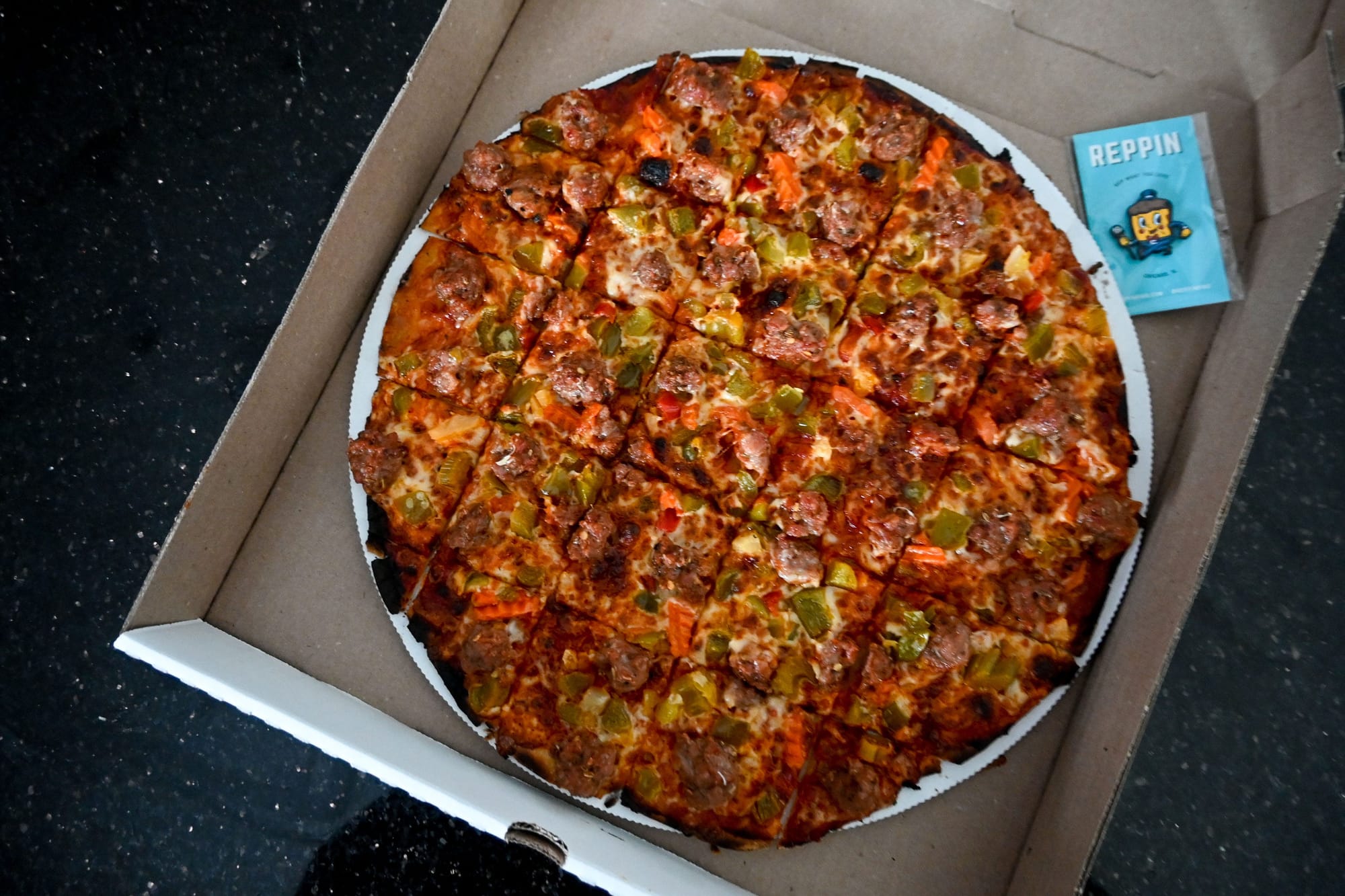
I think the point has been beaten to death by my fellow Chicagoans, but just in case — we just don’t eat that much deep dish pizza here. Nothing wrong with it (yes how clever of you to say casserole, you are the first to think of this), but the pizza that powers the day-to-day gatherings, mealtimes, and celebrations of our city is thin, topped to the edge, and more often than not dotted with sausage befitting the former Hog Butcher For the World. Tavern-style pizza, friends. It’s our way of life.
Call it Tavern-style pizza (herein the preferred term), or Party Cut, or Chicago Thin Crust, or honestly whatever you want to call it except St. Louis.), but it suffers from a strange problem. As a town known for deep dish, we constantly get the “no, not like that, that’s too different.” And then with Tavern-style, we get “well no, that’s too similar to other pizzas in the Midwest.” Well yes, no shit, it would go to reason that the pizza that the denizens of the region’s largest city eat most would influence a region. This pizza style also suffers from Grumpy Old Bastard syndrome from local devotees who whine “we just used to call it pizza,” referring back to the days when you needed a working knowledge of micofiche to truly grasp the regional differences of pizza.
But I digress.
You, friend, YOU are going to love this style. The crust is thin but assertive and flavorful. The sauce is long cooked, conducted to just the right note by a symphony of sweet, savory, sour, and salty elements. The cheese is rich and flavorful, but balanced in application. The bake is coaxed to the pivotal seconds of perfection between “just another sec there” and “ah, shit.”
And the toppings. The toppings! You can make any kind of pizza you want. I do! Bring it fresh and seasonal with farmer’s market ingredients on a white pie. Load the entire might of a South Side deli onto a single pie with ten different plates spinning in universal harmony. Or just craft a bad pun because it makes you happy. Tavern style has room for everyone. So let’s make you one.
The Dough
We use high-gluten flour for this, because we prize strechtability and gluten development. You are more than likely fine using regular ‘ol bread flour if you aren’t futzing with this enough to run a pizzeria from your alley.
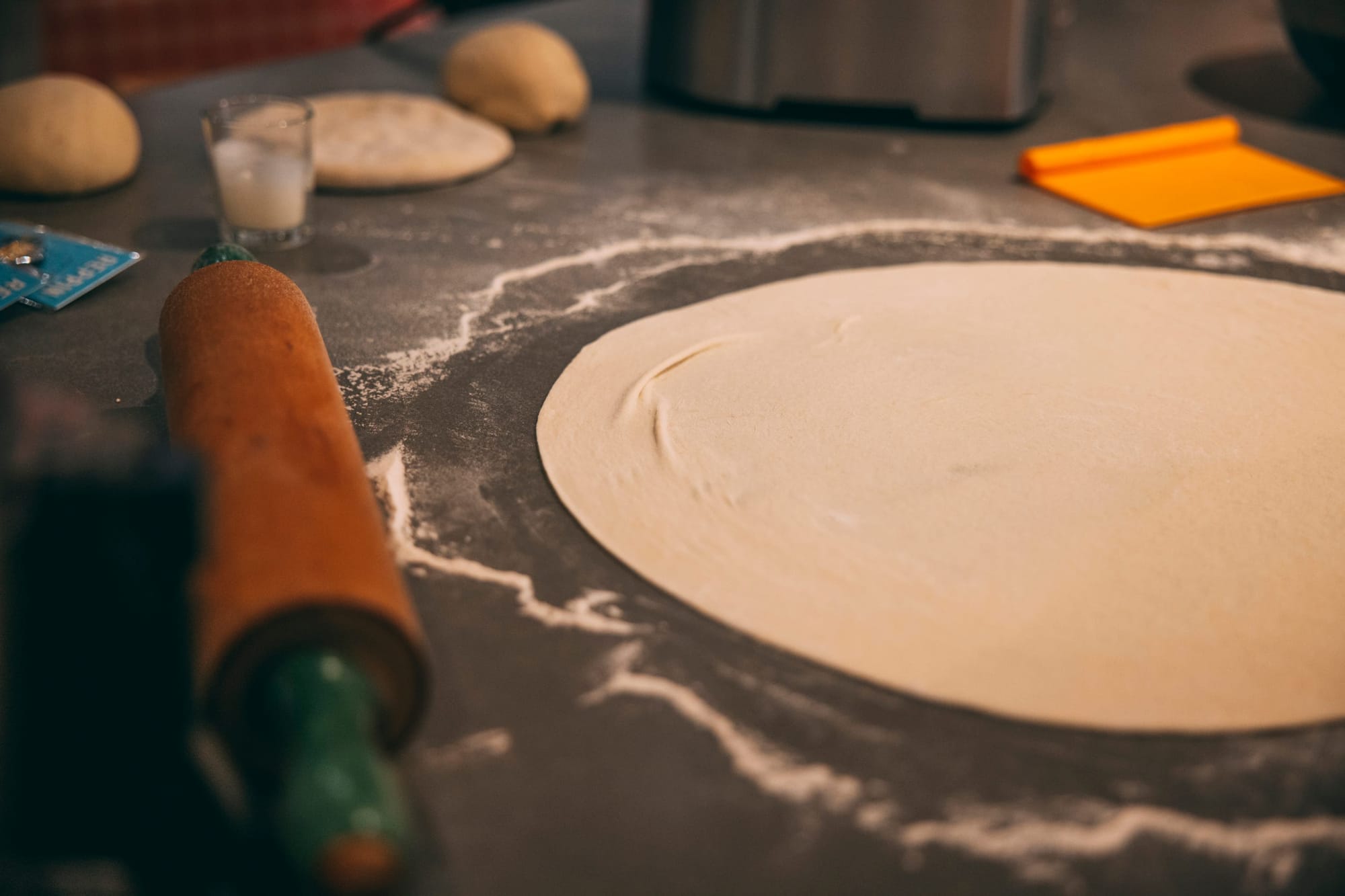
Likewise, I ferment the bastard out of my dough because it increases the stretchability, improves the crispiness, and showcases a yeast-derived fermentation flavor that makes the whole experience better. There isn’t a ton of writing out there about this pizza style, but they almost uniformly ask you to avoid extended fermentation. They’re wrong.
Also I use a food processor. I feel like I’m asking for a lot of trust here. But if you want to do it like I do, let’s get going.
365g high-gluten flour (King Arthur Flour Sir Lancelot or Ardent Mills Kyrol)
13g (4 teaspoons) cornmeal (just use your very cheap Quaker yellow cornmeal, not something medium-grind or fancy)
5g (1 1/4 teaspoons) sugar
5g (1 teaspoon fine) salt
2g (1/2 teaspoon) SAF instant yeast (red label)
185g ice-cold (~35˚F / 2˚C) water
30g olive oil, plus more to store
Add the dry ingredients to the bowl of a food processor fitted with a dough blade2 and pulse to combine.
Clear the sides of the processor bowl with a spatula and pour in the oil and water along the sides.
Run the processor (on the dough setting if yours has it) until the dough begins to cohere and run above the blade. Count to 30, then stop the processor and wait for 20 minutes. (If you’re in the middle of dry winter in the Midwest, and the dough won’t form up, keep a squeeze bottle of water and give it an extra splash or two while the processor is running to help things along.)
Free the dough from the blade and process again, for 40 seconds.
Remove the dough and form into a ball. Divide the dough into two equal balls roughly 295g each and form those into individual balls.
Oil the balls lightly and place each into a 32-ounce3 deli container. Close the lid and label with the date.
Ferment the dough in the fridge, at the very least overnight and at the most aspirational 7 to 10 days. Most of my pies average 4 to 5 days of fermentation. (I’ve kept dough for a month to see what would happen. It PSSSHHHH’d like a pop can and baked up into something very tasty and fermentation-forward.)
TThe night before you want to bake, remove the dough containers from the fridge and let them warm to room temperature, 2 to 3 hours. Then roll out the dough to a 14-inch round4 and dock on both sides with a fork or dough docker. Store the rolled and docked sheets between sheets of nonstick parchment5 and keep in the fridge overnight, uncovered.6 A pan7 under the stack will make it easier to move in and out of the fridge. This is called "curing," and it’s the difference between a pretty good tavern-style pizza and a fantastic one. If you go past 24 hours of curing, the dough will begin to get brittle and curl. So only cure if you’re looking to bake the next day.
The Sauce
I’ve always found sauce to be more art than science.8 I use the same brand of tomatoes 80% of the time, and I still see batch-to-batch variance that makes finishing with salt or (most frequently) acid the most important part. I’m also chasing the sense memories of hundreds of Chicagoland pizzas consumed from my formative years through now, so your experience may vary.
1 tablespoon unsalted butter
1 tablespoon olive oil
4 garlic cloves
85g (3 ounces) tomato paste
14 ounces9 peeled tomatoes with juice (hell, get the San Marzanos if they’re on sale)
1 ½ teaspoons Marmite
1 tablespoon fish sauce (Three Crabs brand or bust)
1 tablespoon red wine vinegar (plus more to taste after blending)
1 ½ teaspoons sugar
¾ teaspoon fine salt (plus more to taste after blending)
1 ½ teaspoons dried basil
1 ½ teaspoons dried marjoram
1 ½ teaspoons dried oregano (grab Mexican oregano if you can get it)
- Heat the butter and oil and fry the garlic until it just starts to take on color.
- Add the tomato paste, nestle the garlic in it above the heat, and cook until the paste begins to darken, about 5 minutes.
- Add the tomatoes and juice and stir.
- Add the Marmite, fish sauce, vinegar, sugar, and salt, and simmer, stirring frequently, for 40 minutes.
- Add the basil, marjoram, and oregano and cook another 5 minutes.
- Blend the sauce with an immersion blender and taste. If you need anything, it’s probably more vinegar. Sometimes it’s more salt. On occasion, I’ve added a little honey or agave nectar to round out the sweetness. Really, really, really sweet pizza sauce is a South Side thing. Nothing wrong with that, but I’m on the North Side.
- If not using immediately, refrigerate and take out of the fridge an hour before using.
The Toppings
We are one of those few towns where sausage far outstrips pepperoni as the #1 topping. The sausage here is good. And if it’s not good, you won’t have to walk far to the next pizza place. But the real magic happens when you pair it with bright, spicy giardiniera. Both the sausage and the giardiniera10 can be mild or hot, and my personal preference is the latter for both.
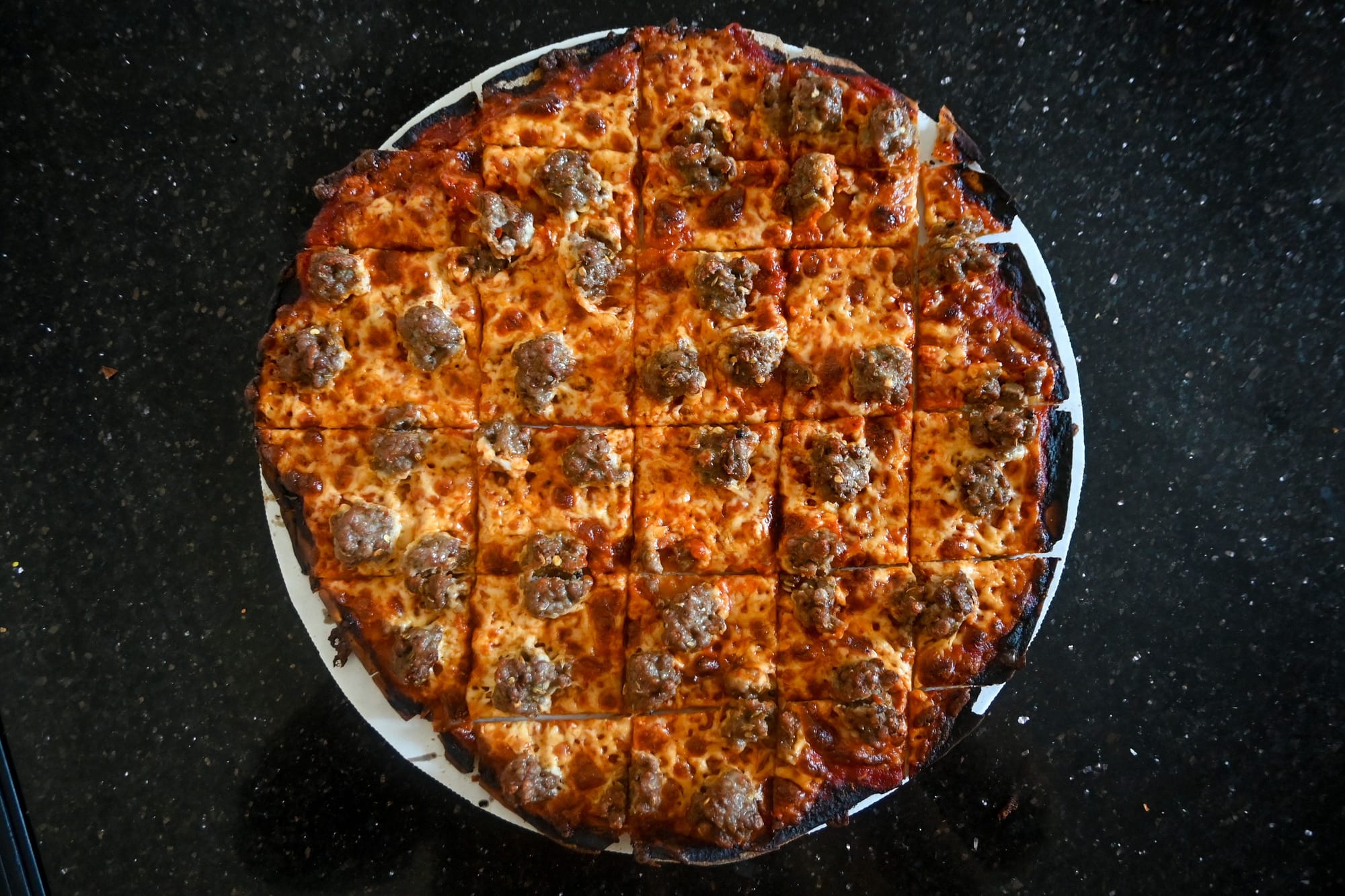
For the sausage, you need good stuff. I make my own, and I have asked too much of your time already. But find yourself a sausagemaker who respects the garlic AND the fennel and you’re golden. For a 14-inch pizza, I add a full 8 ounces of sausage, arranged in alternating lines like you’re building only one color of chessboard squares.
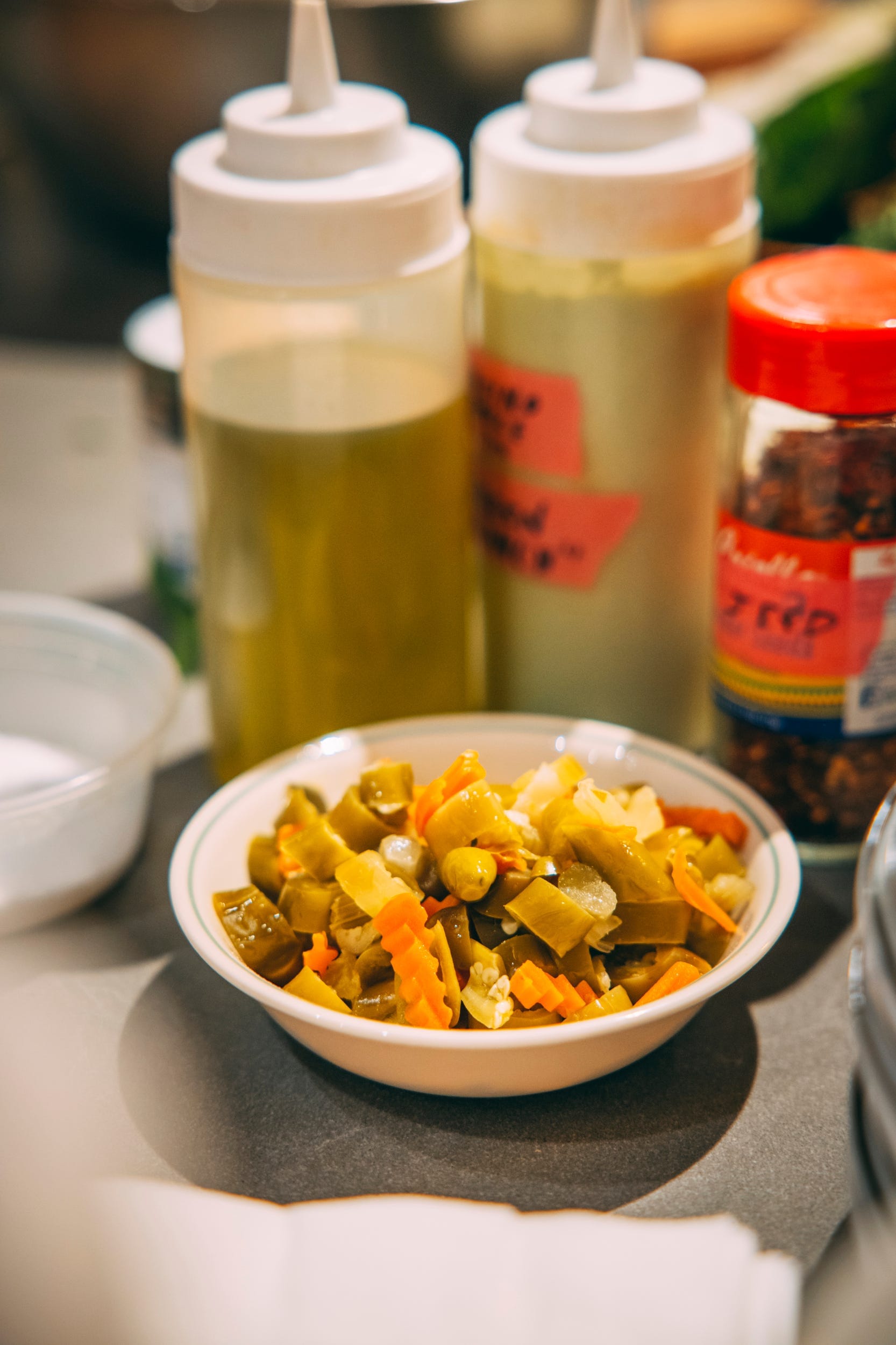
I am not a cocktail guy, but I own several cocktail strainers. And they’re all used for giardiniera-draining purposes. You absolutely need to drain the giardiniera or your pizza will be oily and terrible. But fear not — that oil is its own separate currency. Use it as the base of a fantastic mayo, to poach amazing shrimp, or just as a killer finishing oil. For each 14-inch pizza, you’ll want half of a 16-ounce jar of giardiniera, drained and scattered about the pizza in a mockery of the regimental sausage placement I told you about above.
For the cheeses, you’ll need (per pie):
156g (5.5 ounces) full-fat low-moisture mozzarella, shredded (1 1/3 cups)
57g (2 ounces) Parmesan, processed fine (1/2 cup), divided
(Optionally, you can replace 42g (1.5 ounces) of the mozzarella with white cheddar)
The Bake
Here’s my favorite part — you can absolutely make a tavern-style pizza as good as the restaurant can. This is a utilitarian style based around what bars could execute with home ovens (or larger versions thereof). You can’t claim that for so many styles! But here, you’re chasing 100% completion and that’s a pretty amazing feeling.
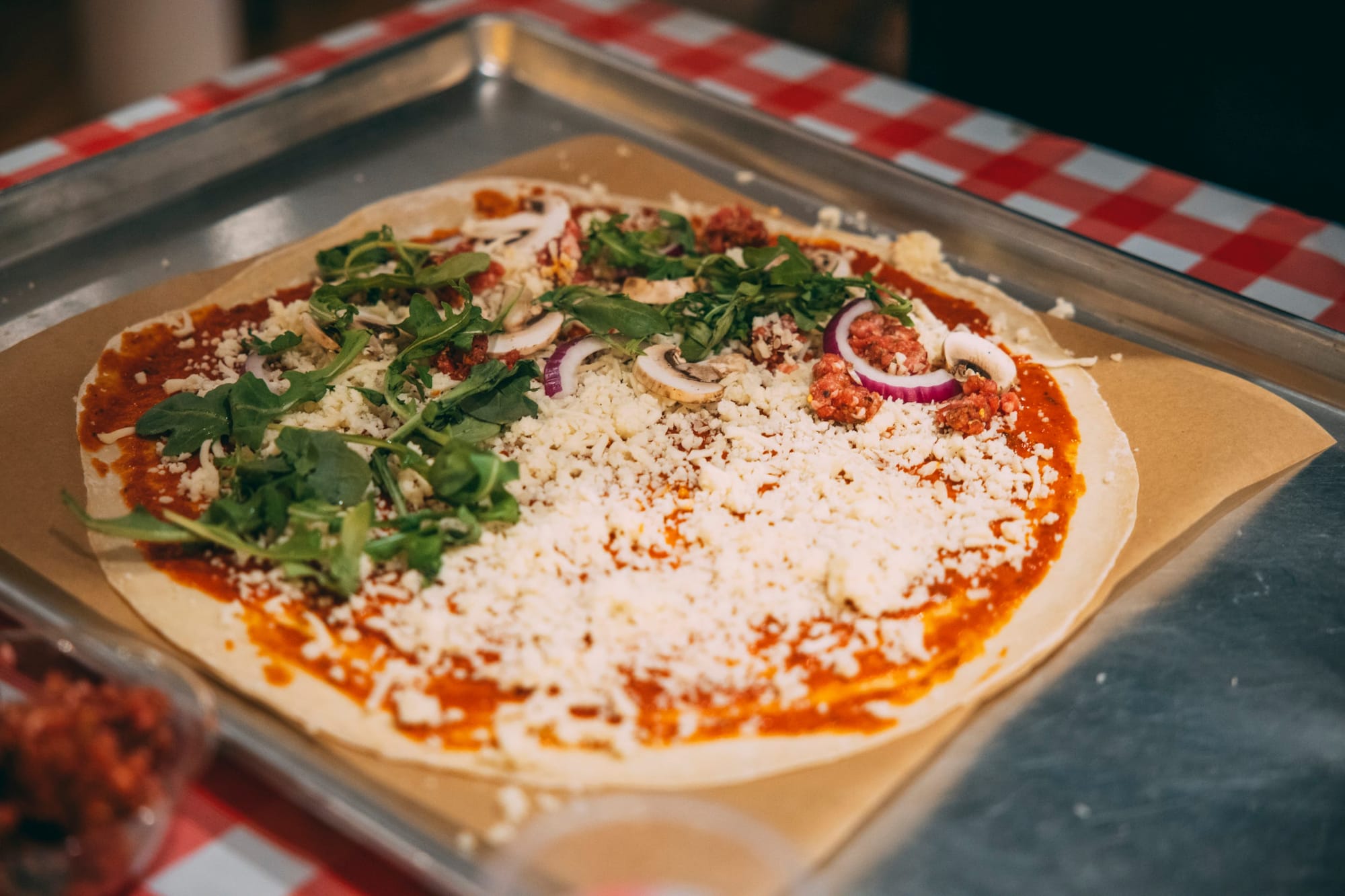
You need a steel for this, which is pretty easy these days. I like a 16-inch steel at 3/8-inch thickness, but I also use a 14-inch at the same thickness and a 14-inch at 1/4-inch to good result. Heat it to 550˚F (or 500˚F is fine if that’s your oven max) for an hour before baking.
Lightly dust a wooden peel with cornmeal. Not too much, as your cured dough won’t be prone to sticking. Turn the dough off of the paper directly onto the peel11 and dock it again if there’s still some moisture.
Spread the sauce thin across the pizza to the edges. Add half the Parmesan, then the mozzarella, the sausage, the giardinera, and the other half of the Parmesan.
Launch the pizza onto the steel and cook undisturbed for 8 minutes.
After 8 minutes, use a metal peel or spatula to rotate the pizza for any uneven cooking and to check the bottom. Sometimes it’ll be done if you’re topping-light. Sometimes it can take another 1 to 4 minutes. The sausage should have some decent browning, and the cheese should be well baked.
Remove from the oven and cool on a rack for 1 to 2 minutes.
Move to a pizza cardboard (you also buy these buy the 50 count, right?) and cut with a rocker cutter. I enjoy a 4 x 4 cut. A lot of Chicago places do 3 x 3. My former bartender friend used to call for delivery cut 5 x 5 because he had a lot of loyal regulars. You do you, but I recommend starting with 4 and exploring the space from there.
Enjoy? I honestly never know what to put in the final step. I hope you dig it.12
2023 fees for Wordloaf contributors are $250 per story/recipe/etc. Contact me if you have something to share! ↩
If you use a metal blade like I do, reduce the first mix time to 15 seconds and the second one to 20 seconds. ↩
Meaning a 1-quart deli container. As John told me: “Larger is pretty essential for the rise you get with the ball. It gets tall and fiesty.” If you don’t have these, use containers of similar volume. ↩
Most people are going to lack the fridge space, pans, and parchment to hold a 14-inch pie. One option is to roll out oval ones that are 16- by 12-inches, which will allow them to fit on standard-width parchment and a rimmed baking sheet. ↩
This is the brand John uses, which is 15 inches wide. If you have narrower paper but still want to roll out a 14-inch pie, just double a few pieces up. ↩
“Curing” the pies is a key step in this recipe, and one reason I wanted to scale it down to two pies instead of four. The point is to dry out the top of the dough, which becomes the bottom, for crispness. When I asked John if he really meant the top dough was supposed to be open to the fridge, here’s what he said: “UNCOVERED! Benuded. I realize it's counterintuitive but it's what makes the magic happen. The lower-stack crusts end up a little less dry, and that's fine, but I'd do these individually on parchment-lined hotel pans in a speed rack in a walk-in if I had unlimited resources.” If you have the fridge space and pans to leave each dough uncovered, you should definitely do it. ↩
Use a pizza serving pan if you have one, or a rimless cookie sheet. Or a 14-inch round of cardboard. Whichever you use, remember that the pan is only for curing the dough, not baking it. You are going to bake the pies directly on the baking surface. ↩
Agreed, which is why I didn’t convert the spoons amounts here to weights. ↩
Sorry for the annoying amount here, it’s my fault for dividing the recipe in half. ↩
John recommends either Caruso or Marconi brands of giardiniera. ↩
If you are paranoid about building such a thin pie on a peel and baking it directly on a steel, do as John suggested and build and bake it (initially) on a second sheet of parchment: “You can slide the pizzas on parchment in and then remove it halfway through as you rotate the pizza. I do that sometimes if I don't have enough space for completely cured doughs for an event. But it's one more thing, so I don't usually add it to an already fussy recipe.“ ↩
I know you will. ↩
wordloaf Newsletter
Join the newsletter to receive the latest updates in your inbox.


